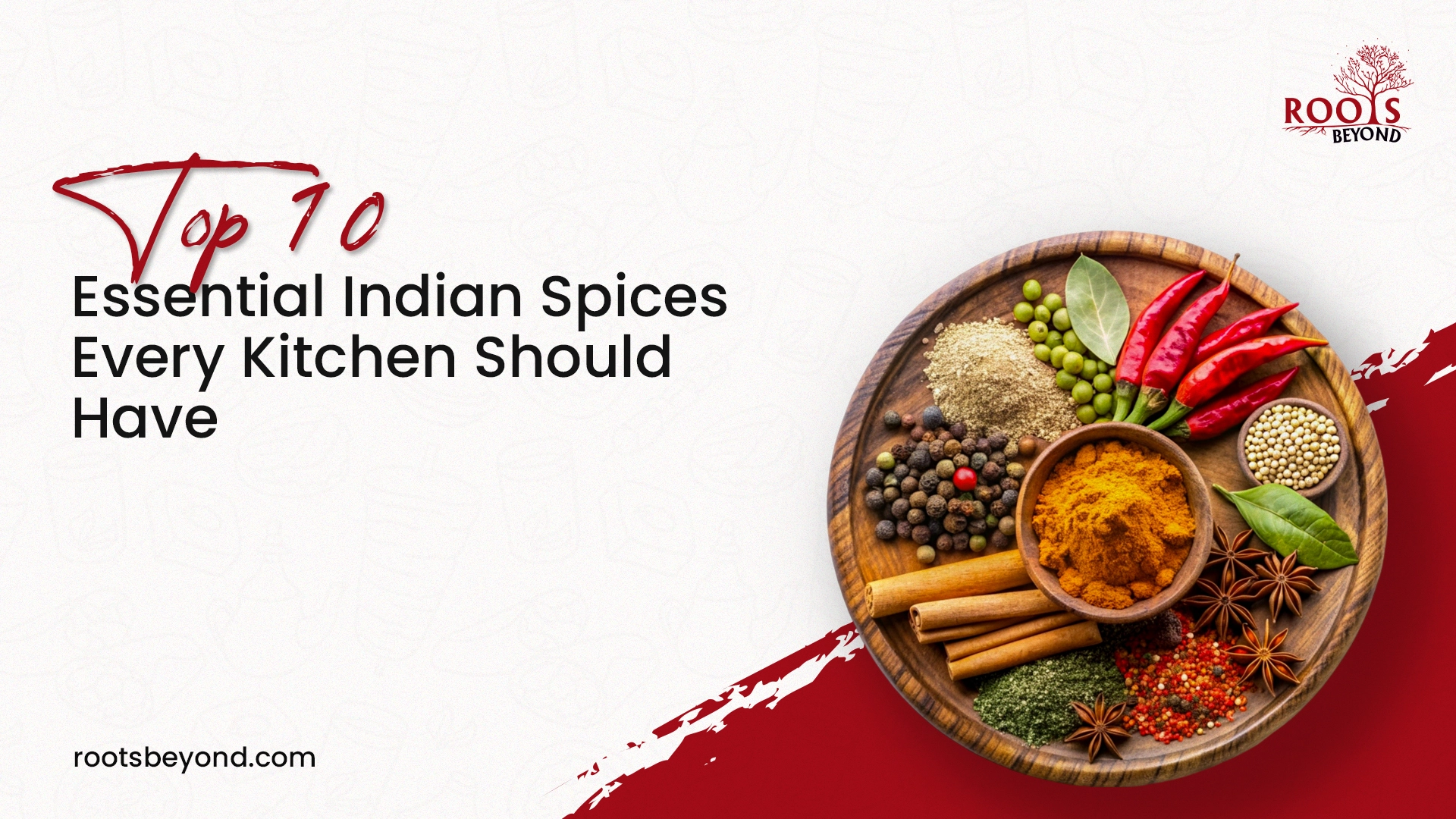Top 10 Essential Indian Spices Every Kitchen Should Have

1. Turmeric (Haldi)
Turmeric is instantly recognisable for its golden-yellow hue. Used in curries, dals, and even warm drinks like turmeric milk, it adds colour and earthiness to food. In traditional Ayurvedic practice, turmeric has been valued for its balancing qualities. In cooking, just a pinch elevates everything from rice dishes to soups.2. Cumin (Jeera)
Cumin has a warm, nutty flavour that shines when roasted. A spoonful of tempered cumin seeds in hot oil forms the base of countless Indian dishes. Historically, cumin has been treasured for its digestive properties, and even today, cumin-infused water is a common household remedy.3. Coriander Seeds (Dhaniya)
Mild and citrusy, coriander seeds provide brightness to curries, pickles, and spice blends. Ground coriander is widely used, but whole seeds, dry-roasted and crushed, add a rustic charm to recipes. Their balanced flavour makes them an essential bridge between robust spices and delicate herbs.4. Mustard Seeds (Sarson)
These tiny black, brown, or yellow seeds pack a punch when they hit hot oil. They release a sharp, nutty aroma that defines many South Indian dishes and pickles. Beyond flavour, mustard seeds have been historically used in preserving foods, ensuring they last longer in warm climates.5. Cardamom (Elaichi)
Cardamom, traditionally known as the “queen of spices,” lends a sweet yet complex fragrance. Green cardamom is popular in desserts and masala chai, while black cardamom brings a smoky note to gravies and rice. This spice has been part of festive cooking for centuries, symbolising luxury and indulgence.6. Cloves (Laung)
Cloves are small but mighty. Their intense, warming flavour is used in biryanis, spice blends, and even teas. In traditional Ayurvedic practice, clove oil was applied for oral care, and even today, cloves remain closely associated with festive and winter recipes.7. Cinnamon (Dalchini)
Cinnamon adds a sweet-spicy depth to both savoury curries and sweet treats. Unlike its European use mainly in desserts, in Indian cooking, it is often a key component of garam masala. Its woody fragrance creates a comforting base for slow-cooked dishes.8. Fenugreek (Methi)
Fenugreek seeds are slightly bitter but balance beautifully when used in moderation. They are a staple in pickling and spice blends like panch phoron. Interestingly, fenugreek leaves and seeds are both used in Indian kitchens, showing their versatility beyond just seasoning.9. Red Chili Powder (Lal Mirch)
Chili powder adds the signature heat that many associate with Indian food. Yet, it’s not just about spice; different varieties, from Kashmiri to Guntur, bring varying shades of colour and depth of flavour. A small amount can transform a dish’s personality, making it bold and fiery.10. Asafoetida (Hing)
Unique to Indian cooking, asafoetida is prized for its pungent aroma that mellows into a savoury, umami-like flavour. Just a pinch is enough to lift lentil dishes and vegetable curries. Traditionally, it was also used to make legumes more digestible, reflecting its practical role in everyday cooking.Why These Spices Matter
What makes these the best Indian spices isn’t just their flavour but what they unlock in your own kitchen. For a beginner, stocking even a few from this Indian spice list, like turmeric, cumin, and coriander, can instantly transform simple vegetables, rice, or lentils into meals rich with depth and balance. For more experienced cooks, layering spices like cardamom, cloves, and cinnamon allows you to recreate festive dishes that carry the same fragrance and warmth you remember from home.
If you’re just starting out, think of these ten spices as a starter kit. Begin with three or four essentials and gradually expand your collection. This way, you build confidence without feeling overwhelmed, while still capturing the essence of authentic Indian cooking.
Here at Roots Beyond, “we are passionate about bringing the rich and diverse flavors of India to kitchens across the USA, specializing in importing and distributing authentic Indian spices” (Roots Beyond). That means you don’t have to compromise on quality or authenticity, you can access the same trusted Ramdev Masala spices your family has relied on in India, now available locally.
Conclusion
Cooking with Indian spices is more than seasoning, it’s a way of keeping traditions alive, creating comfort at the table, and telling your own food story. Whether it’s the earthy warmth of cumin in a dal or the sweet fragrance of cardamom in a festive dessert, each spice brings something irreplaceable to everyday meals.
And the best part? You don’t need to search specialty aisles endlessly. We now bring you the trusted taste of Indian cuisine straight to local stores across the Irving, so you can enjoy authentic flavours with ease and confidence.
Use this spice list as your next grocery guide and bring home the timeless taste of Indian cooking, made simple with Roots Beyond’s premium collection.
Share via:
